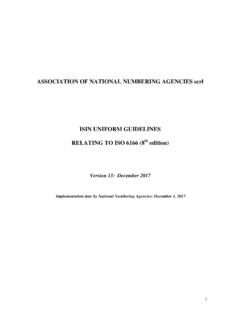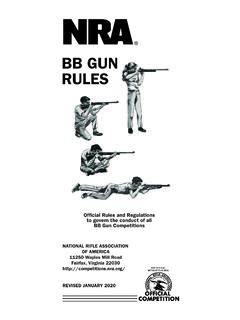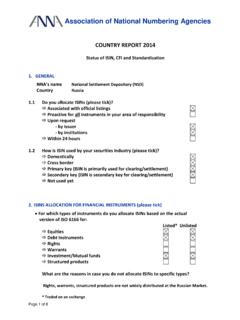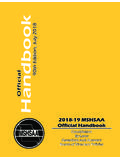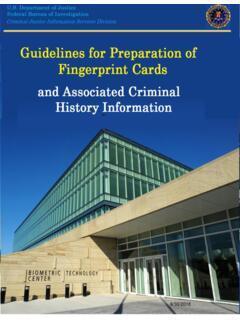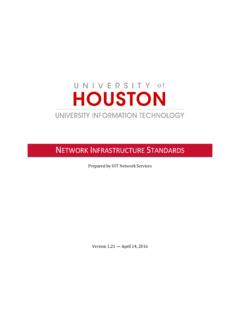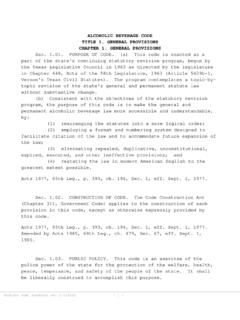Transcription of Street Addressing Standards and Guidelines for the State ...
1 Street Addressing Standards and Guidelines for the State of Georgia Prepared by Georgia Spatial Data Infrastructure GIS Coordinating Committee Framework Transportation Technical Working Group August 2000 Street Addressing Standards and Guidelines iFOREWORD This guideline was produced by The University of Georgia s Office of Information Technology Outreach Services (ITOS) under contract with Georgia s GIS Coordinating Committee as part of a collaborative effort to develop the State of Georgia s core Geographic Information System (GIS) base map. Street Addressing Standards and Guidelines iiTABLE OF CONTENTS 1 1 2 2 3 2 3 Physical Address & Mailing Address .. 3 3 Address 4 Roads Database with Address Ranges (RDAR) .. 4 REVIEW OF EXISTING 6 United States Postal Service (USPS) .. 6 US Census Bureau (USCB).. 7 Roads Database (RDAR) .. 7 Address 9 Alphabetic Case.
2 9 national Emergency numbering association (NENA) .. 10 Address 10 Roads Database (RDAR) .. 10 Georgia Department of Transportation (GDOT) .. 11 American Planning association (APA) .. 11 RECOMMENDED Standards AND Guidelines FOR 12 ESTABLISHING A REFERENCE POINT AND 12 Establishing a Reference Point .. 12 Establishing Baselines .. 12 Street 13 General Principles of Assigning Pre-Directions .. 15 General Principles of Assigning Street Names .. 15 General Principles of Assigning Street 19 General Principles of Assigning Quadrants .. 19 Street 21 Street Addressing Standards and Guidelines Assign Each Street an Order .. 21 Assign Each Street a Parent .. 22 Assign Address 23 (a) First Order 23 (b) Higher Order 24 (c) Special Cases .. 26 (a) Advantages of This System .. 28 (b) Disadvantages of This 30 HOUSE 30 Corner 31 Stacked 31 Apartments and Duplexes.
3 31 Businesses .. 32 Mobile Home 32 7 33 RECOMMENDED DATABASE 33 Recommended Design of Address Database (Minimum Content) .. 33 Recommended Design of RDARs (Minimum Content) .. 34 Justification for Width and Data Type Recommendations .. 35 Street TYPES WITH 38 POTENTIAL ADDRESS DATA 42 8. SELECTED 43 Street Addressing Standards and Guidelines iv Street Addressing Standards and Guidelines 11 INTRODUCTION Because the property address is a fundamental component of any government service delivery system, it must be assigned through a logical and consistent procedure. The importance of proper Addressing cannot be overstated; during an emergency it can mean, quite literally, the difference between life and death. Additionally, Addressing helps define educational and political districts, and affects the quality of services available to citizens.
4 A logical and consistent Addressing system, therefore, can tangibly improve the quality of life in a community. Unfortunately, the importance of the Addressing task is frequently overlooked, resulting in Addressing schemes that are often unorganized or incomprehensible and that lead to inefficient and ineffective governmental and commercial service delivery. But easily understood Addressing systems are not simple to design and maintain. Local governments have found that managing a coherent Addressing system can be difficult even under the best circumstances. During periods of steep growth, existing flaws in Addressing systems -- duplicate Street names, unnecessary name changes, non-sequential numbering , etc. can cause small inconsistencies to propagate through the system, creating even larger problems. Currently, many Georgia counties do not use municipal style addresses ( , 101 E Main St SE), but conversion from the old system of rural routes and boxes is inevitable as more counties implement 911 systems.
5 The Standards and Guidelines in this document are designed to make the process a little easier and to help make Addressing across the State of Georgia more consistent. Citizens usually bear the cost of poorly designed Addressing systems through inefficient government services and through lost business when potential customers are unable to locate an establishment. Poorly designed Addressing systems result in postage increases, delivery delays, lost parcels, and even loss of property and life. Yet ironically, those most likely to oppose the revamping of older Addressing systems (which may contain errors likely to interfere covertly with services) are the local citizens and businesses themselves, who may be required to revise subscriptions and billing, or to reprint labels, stationery, and the like. As a result, public officials who are aware of the dangers posed by Addressing -system problems may discover that their constituencies do not support change.
6 Education and public involvement are essential elements Street Addressing Standards and Guidelines 2in developing a comprehensive solution. Citizens must know why it is necessary to readdress, and they must be provided an opportunity to participate in the process. Today there are various tools to help implement a new Addressing system or revamp an existing one. Although Geographic Information System (GIS) tools will not make the political process any easier, they certainly make technical implementation much simpler, faster, and more consistent. This document was written with GIS implementation in mind; most, if not all, of the applications described in this document will be applicable to the non-digital world, but the Standards herein were developed primarily for electronic implementation. 2 PURPOSE In the development of this document, political concerns were necessarily attenuated, while safety and efficiency concerns remained paramount.
7 The purpose of this document, Street Address Standards and Guidelines for the State of Georgia, is to assist county and municipal governments with implementing and maintaining a consistent, safe, useful, and standardized Addressing system. 3 GOALS The primary goal of this report is to provide local government agencies with a complete set of Addressing Guidelines , so that Addressing may become more consistent statewide and efficiency of government services such as emergency response may be improved. Secondary goals include: To improve the quality of life for residents of Georgia through improved delivery of mail and services; To project a positive and progressive image to residents, prospective residents, and developers; To make address location simpler for residents and businesses; Street Addressing Standards and Guidelines 3 To emphasize the importance of a consistent, county-wide Addressing system; To promote the use of GIS for creation and maintenance of a roads database with address ranges (RDAR).
8 TERMINOLOGY In order to understand the following recommended Standards , one must first understand the difference between a physical address and a mailing address, as well as the difference between an address database and a roads database with address ranges (RDAR). Physical Address & Mailing Address A physical address describes where a dwelling, business, or lot is physically located, not necessarily where mail is received. For instance, a person may reside at 123 N America St NE, but receive mail at PO Box 128. The PO box is a mailing address, while 123 N America St NE is a physical address. Parsing During data entry, both physical and mailing addresses should be broken down into as many components as possible, a process known as parsing. See examples of parsed and unparsed physical address formats below. (Note: For mailing addresses, an additional column should be included for PO boxes).
9 Street Addressing Standards and Guidelines 4 Unparsed Address Database NAME ADDRESS Doe, Jane C., Dr. 123 N America St NW Smith, Joe B. Jr. 125 Oak St SE Jones, Terry 357 Magnum Rd NE Parsed Address Database LAST-NAME MI FIRST-NAME TITLE NAME- SUF HOUSE-NUM PRE-DIR ST-NAME ST- TYPE QUAD Doe C Jane Dr 123 N America St NW Smith B Joe Jr 125 Oak St SE Jones Terry 357 Magnum Rd NE Address Database An address database, for the purposes of these Guidelines , is a database that contains specific physical addresses, which describe a location for receipt of emergency services, utilities, et al.
10 It is not uncommon for agencies and businesses to maintain databases containing both physical and mailing addresses, as service and billing locations are not always identical. This document is written with concern for physical addresses only, but the recommendations given for physical addresses can be closely followed for mailing addresses as well. Roads Database with Address Ranges (RDAR) The differences between an address database and a roads database with address ranges (RDAR) are just as significant as the differences between a physical address and a mailing address. As mentioned above, an address database is a collection of any number of specific addresses, each of which correlates to one (and only one) spot on the earth. A RDAR, on the other hand, records the acceptable range of addresses for every Street or portion of a Street in an area. For example, a specific address might appear in an address database as 124 N America Street NW.
